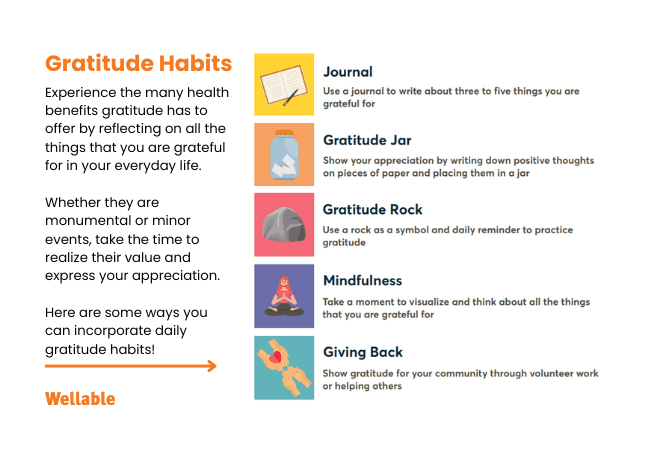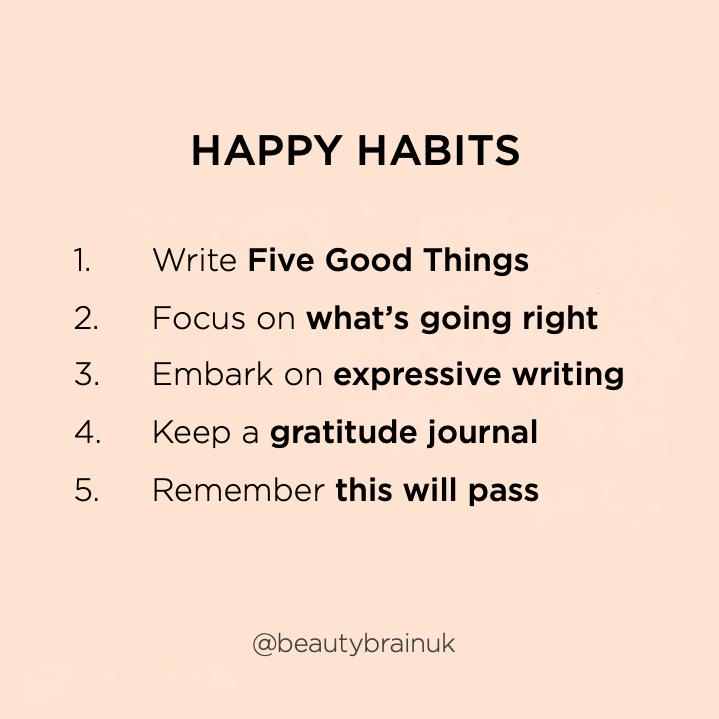8 Gratitude Habits for a Happier Life
1. Start a Gratitude Journal
Gratitude journaling is a powerful habit that can transform your mindset and outlook on life. Taking just a few minutes each day to write down what you are grateful for can shift your focus from what is lacking in your life to what is abundant. Keeping a gratitude journal can help you cultivate a positive mindset, increase your levels of happiness, and reduce stress and anxiety.
To start a gratitude journal, simply set aside a few minutes each day to reflect on what you are thankful for. You can write about big or small things, such as a good cup of coffee in the morning, a supportive friend, or a beautiful sunset. The key is to focus on the positive aspects of your life and express your appreciation for them in writing. Over time, this practice can help you develop a more optimistic outlook and a greater sense of well-being.

In addition to writing down what you are grateful for, you can also use your gratitude journal to reflect on the reasons behind your feelings of gratitude. This can help you deepen your appreciation for the good things in your life and foster a sense of mindfulness and presence in the moment. By making gratitude journaling a daily habit, you can create a positive feedback loop that enhances your overall happiness and well-being.
2. Practice Mindful Gratitude
Mindful gratitude involves paying attention to and appreciating the present moment and all the good things that it contains. By practicing mindful gratitude, you can train your mind to focus on the positive aspects of your life and cultivate a greater sense of contentment and well-being. This habit can help you become more aware of the abundance that surrounds you and foster a deeper sense of gratitude for the small joys and blessings in your life.

One way to practice mindful gratitude is to incorporate gratitude into your daily mindfulness practice. This can involve taking a few moments each day to pause and reflect on what you are thankful for in the present moment. You can focus on your breath, your senses, or the sights and sounds around you, and express your gratitude for the simple pleasures of life. By bringing your awareness to the present moment and acknowledging the good things in your life, you can cultivate a sense of gratitude that enhances your overall happiness and well-being.
Another way to practice mindful gratitude is to incorporate gratitude into your daily routines and activities. This can involve expressing appreciation for the people you interact with, the tasks you complete, or the experiences you have throughout the day. By infusing your daily life with gratitude, you can shift your focus from what is lacking to what is abundant and create a more positive and fulfilling experience. By practicing mindful gratitude regularly, you can develop a greater sense of appreciation for the present moment and cultivate a happier and more fulfilling life.
3. Cultivate a Gratitude Mindset

Cultivating a gratitude mindset involves adopting a positive and appreciative attitude towards life and all its experiences. By focusing on the good things in your life and expressing gratitude for them, you can shift your perspective from one of scarcity to one of abundance. This mindset can help you develop a greater sense of optimism, resilience, and well-being, and enhance your overall happiness and fulfillment.
One way to cultivate a gratitude mindset is to practice reframing negative experiences in a more positive light. This can involve looking for the silver lining in challenging situations, finding lessons and growth opportunities in setbacks, and acknowledging the blessings and support that exist even in the face of adversity. By adopting a gratitude mindset, you can train your mind to see the good in every situation and cultivate a more positive and resilient outlook on life.
![[-Minute Video] Gratitude Habits for a Happier Life in a Post-Pandemic World [-Minute Video] Gratitude Habits for a Happier Life in a Post-Pandemic World](https://i.ytimg.com/vi/pkXi7oPp6Qw/hq720.jpg?sqp=-oaymwEhCK4FEIIDSFryq4qpAxMIARUAAAAAGAElAADIQj0AgKJD&rs=AOn4CLDH6jym3tmT58oFseAd5UC8RkQG6w)
Another way to cultivate a gratitude mindset is to surround yourself with positive influences and practice gratitude in your relationships. By expressing appreciation for the people in your life, the experiences you share, and the support you receive, you can strengthen your connections, foster a sense of belonging and community, and enhance your overall well-being. By cultivating a gratitude mindset in your interactions and relationships, you can create a more positive and fulfilling experience and cultivate a happier and more meaningful life.
4. Practice Random Acts of Kindness
Practicing random acts of kindness is a powerful way to cultivate gratitude and enhance your happiness and well-being. By performing acts of kindness for others, you can shift your focus from your own problems and concerns to the needs and well-being of others, and experience the joy and fulfillment that comes from helping others. This habit can help you develop a greater sense of empathy, compassion, and gratitude, and enhance your overall sense of happiness and fulfillment.

One way to practice random acts of kindness is to perform small, thoughtful gestures for the people in your life. This can involve sending a kind message to a friend, helping a neighbor with a task, or giving a compliment to a stranger. By expressing kindness and gratitude towards others, you can create positive connections, foster a sense of community, and enhance your own sense of well-being. By making random acts of kindness a regular practice, you can cultivate a more positive and fulfilling experience and enhance your overall happiness and satisfaction.
Another way to practice random acts of kindness is to volunteer your time and resources to help those in need. This can involve participating in community service projects, donating to charitable organizations, or supporting causes that are meaningful to you. By giving back to others and making a positive impact in the world, you can cultivate a greater sense of purpose, meaning, and gratitude, and enhance your overall well-being and happiness. By practicing random acts of kindness regularly, you can create a more positive and fulfilling experience and cultivate a happier and more meaningful life.
5. Express Gratitude to Others

Expressing gratitude to others is a powerful way to cultivate positive relationships, strengthen connections, and enhance your overall happiness and well-being. By acknowledging and appreciating the people in your life, you can create a sense of belonging, foster a deeper sense of connection, and enhance your own sense of fulfillment and satisfaction. This habit can help you cultivate a greater sense of empathy, compassion, and gratitude, and create a more positive and fulfilling experience.
One way to express gratitude to others is to simply say thank you. This can involve acknowledging the acts of kindness, support, and generosity that others show you, and expressing your appreciation for their efforts and contributions. By saying thank you regularly and sincerely, you can create a culture of gratitude in your relationships, strengthen your connections, and enhance your overall well-being. By expressing gratitude to others, you can cultivate a more positive and fulfilling experience and enhance your own sense of happiness and fulfillment.

Another way to express gratitude to others is to show appreciation through acts of kindness and generosity. This can involve giving gifts, performing favors, or offering assistance to the people in your life. By demonstrating your gratitude through actions, you can create positive connections, foster a sense of community, and enhance your own sense of well-being. By expressing gratitude through acts of kindness, you can cultivate a more positive and fulfilling experience and enhance your overall happiness and satisfaction.
6. Practice Gratitude Meditation
Gratitude meditation is a powerful practice that can help you cultivate a greater sense of appreciation, contentment, and well-being. By focusing on feelings of gratitude and appreciation during meditation, you can train your mind to see the good in every situation, cultivate a more positive outlook on life, and enhance your overall happiness and fulfillment. This habit can help you develop a greater sense of mindfulness, presence, and gratitude, and create a more positive and fulfilling experience.
To practice gratitude meditation, find a quiet and comfortable space where you can sit or lie down in a relaxed position. Close your eyes and take a few deep breaths to center yourself and relax your body and mind. Then, bring to mind something that you are grateful for, such as a person, a place, or an experience, and focus on the feelings of gratitude and appreciation that arise. Allow yourself to fully immerse in these feelings and let them fill you with a sense of warmth, joy, and well-being.
As you continue to practice gratitude meditation, you can explore different aspects of your life that you are thankful for and cultivate feelings of gratitude and appreciation for all the good things that surround you. By making gratitude meditation a regular practice, you can train your mind to see the positive aspects of your life, cultivate a greater sense of contentment and well-being, and enhance your overall happiness and fulfillment. By incorporating gratitude meditation into your daily routine, you can create a more positive and fulfilling experience and cultivate a happier and more meaningful life.
7. Create a Gratitude Jar
Creating a gratitude jar is a simple yet powerful way to cultivate gratitude and enhance your happiness and well-being. By filling a jar with notes of gratitude and appreciation, you can create a visual reminder of all the good things in your life, and cultivate a greater sense of positivity, contentment, and fulfillment. This habit can help you focus on the abundance that surrounds you, shift your perspective from what is lacking to what is abundant, and enhance your overall sense of well-being and happiness.
To create a gratitude jar, find a jar or container that you like and decorate it in a way that inspires you. You can use stickers, markers, or paint to personalize your jar and make it a reflection of your personality and style. Then, fill the jar with small pieces of paper or notes on which you write down things that you are thankful for. These can be big or small things, such as a kind gesture from a friend, a beautiful sunrise, or a delicious meal.
As you continue to fill your gratitude jar with notes of appreciation, you can create a visual representation of all the good things in your life and cultivate a greater sense of gratitude and contentment. By taking a moment each day to reflect on what you are thankful for and add it to your jar, you can create a positive feedback loop that enhances your overall sense of well-being and shifts your focus away from what’s lacking to what’s already abundant in your life. Over time, this simple practice can rewire your mindset, helping you see challenges as opportunities and small moments as sources of joy. Each note becomes a reminder that even on difficult days, there are still things worth appreciating — whether it’s a kind gesture, a beautiful sunset, or simply the comfort of a warm meal.
As your jar begins to fill up, it becomes more than just a collection of notes — it transforms into a powerful symbol of personal growth and positivity. On days when you feel overwhelmed or discouraged, revisiting these messages of gratitude can reignite your motivation and remind you of how far you’ve come. This tangible evidence of your blessings encourages resilience and reinforces the idea that happiness is built through consistent appreciation, not grand achievements.
Sharing your gratitude practice with family, friends, or students can also inspire a ripple effect of positivity. Encouraging others to start their own gratitude jars fosters a culture of thankfulness and emotional well-being in your community. When people take time to notice and celebrate the good in their lives, it strengthens relationships and creates a more compassionate, supportive environment — proving that gratitude, when shared, multiplies.